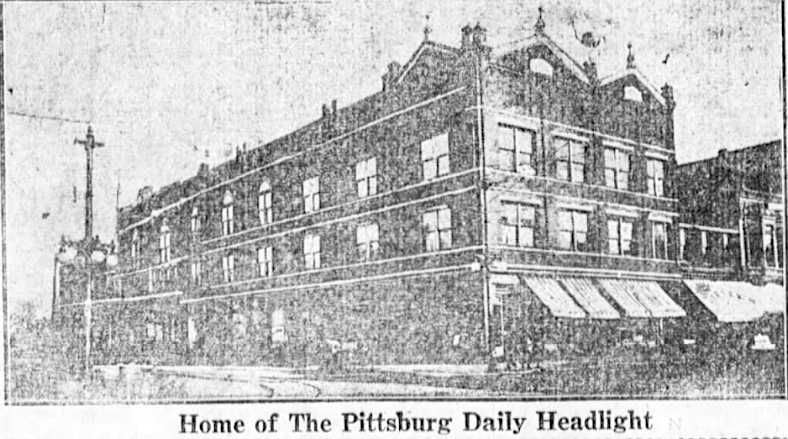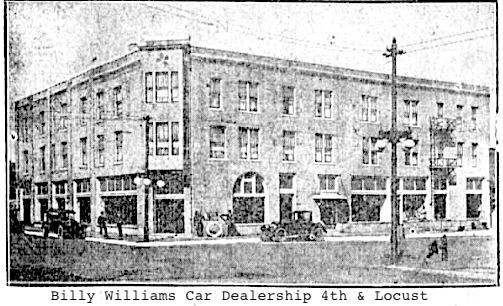
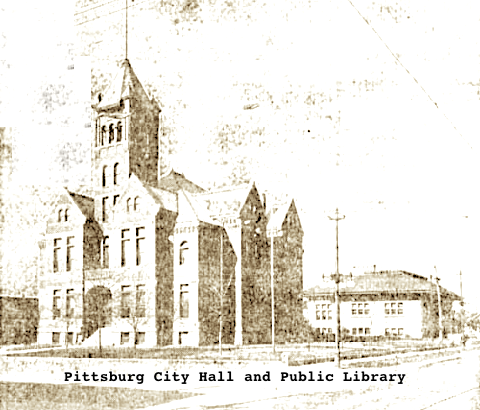
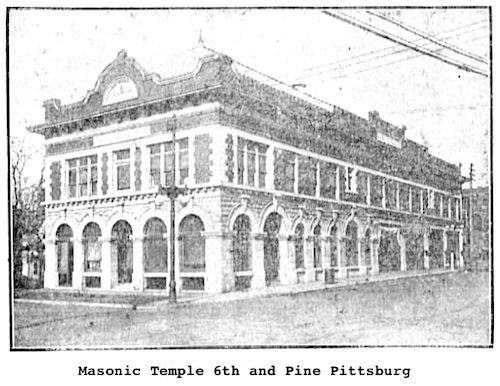
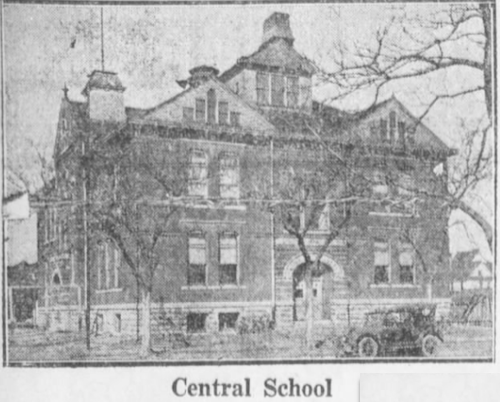
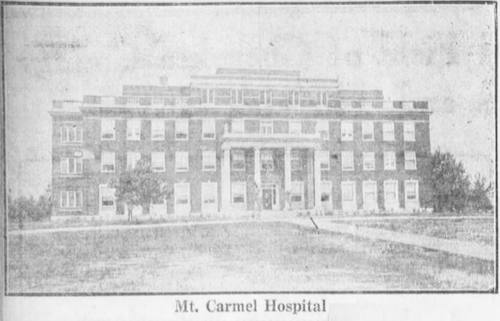
Boomtown!1921 Pittsburg, Kansas
by Holly Swigart July 19, 2022
"Buy Pittsburg Pasta!" said the sign in the front window of the Macaroni Factory at 818 N. Broadway. In the street out front, Wilbur Ferguson was busy setting up his camera equipment. Wilbur was a seasoned photographer having worked for decades with his sisters, Anna and Minnie at their family business, Ferguson's Photography. It was a beautiful Spring morning in 1921, and the Macaroni Factory was Wilbur's first stop. Today's assignment was to travel around Pittsburg and shoot photos of businesses, churches, parks and schools for a special edition of the Pittsburg Headlight Newspaper. Ferguson's Photography was known for its artistic work, and Wilbur considered this an exciting opportunity to capture and preserve a moment in history. The 76 page special edition would promote "Prosperous Pittsburg," on the 45th anniversary of its founding.
As Ferguson made his way around town, there were so many sights to see. One of the first along the way was Dr. SEE SEE, the optometrist office of C.C. Stevenson at 618 N. Broadway. The good doctor posed in front of his building while pointing to a large banner that read THE ONLY DR. SEE SEE.
At 1010 N. Broadway, Archie Kirkwood was hard at work in his blacksmith shop, but was happy to take time to share his story. Born in Scotland in 1866, he came to America when he was only nine years old. He was the first blacksmith employed by the Santa Fe Coal Co. in Frontenac. After many years of blacksmithing, he became interested in automobiles, and it seems he was a natural born mechanic. Working on cars eventually became the largest part of his business, although he still offered blacksmith services for those who needed it.
John Friggeri's shop simply had his name on the striped awning out front. A large plate glass window displayed a selection of jewelry and watches. John was born in Parma, Italy, in 1882. His family migrated to South America where he learned the trade of watchmaking. When he decided to come to America, he arrived in Pittsburg with no money, so he did what so many had done who needed a job quickly. He went to work in the coal mines. After eighteen months of hard labor, he had managed to save $80. He used his savings to open his own "Watch Hospital" located at 315 N. Broadway. The business grew and before long expanded into a jewelry store.
A large 3 story brick building at 1211 N. Broadway had giant letters painted on the side that spanned the entire length of the building spelling out the name: Pittsburg Candy Company. The manager, J.R. Hinkle was eager to report sales of over 1,500,000 Mexican Hot Cakes, Dixie Bars and School Boy Suckers in one year. That's amazing considering they had started out as a Candy Wagon, only a few years earlier.
Sam and Oscar opened their clothing store at 513 N. Broadway in 1907. Both men had worked for years as salesmen for other shops in town, so when they threw in together and started their own business, they already had a following. Their store was instantly popular. Everyone loved their eye-catching, colorful window displays.
Beck and Hill provided meat fresh from their 160 acre farm and slaughter house in Chicopee. Charles Beck grew up in Pittsburg. and at the age of 18, moved to Kansas City. There he worked for seven years in one of the large meat packing houses learning the trade. When Beck returned to his hometown and partnered with Clyde Hill, their butcher shop became the place to go for quality meat.
Pittsburg truly was a boom town 100 years ago. Several giants of industry had made their home in Pittsburg, including Tom McNally who arrived in 1886 and started the Boiler & Machine works, The Nesch Brothers Brick Plant and Lanyon's Smelters also employed large work forces, as did Dickey Clay, which manufactured clay pipe on a huge scale. With a population of 20,000 in 1921, Pittsburg offered opportunities for employment and education. The Kansas State Manual Training Normal School drew 4,000 students to its campus, which was small in 1921, but was expanding and would eventually become Pittsburg State University.
Pittsburg did not yet have the Besse Hotel or Memorial Auditorium, but it certainly had plenty of examples of beautiful architecture. Simply standing at the intersection of 4th and Broadway was awe inspiring. On each corner, stood a masterpiece. The Globe building, the Commerce Building and the Lanyon Building, each unique and artistic in design, greeted travelers in the heart of downtown Pittsburg. The old Opera House had been transformed by Asa Messenger, of Messenger's Lumber Co. who was not only a contractor and builder, but also an architect. He converted the 2nd and 3rd floors into offices and apartments and created an elegant interior for the National Bank on the first floor. Pittsburg City Hall stood like a castle towering above the new public library on West 4th St. and the Masonic Temple at 6th and Pine with its beautiful rows of stone arches was yet another attraction for sightseers, along with the magnificent Stilwell Hotel at 7th and Broadway.
Visitors to the city were in for a real treat if they made a stop at the Wayfarer Tea Room at 116 W. 4th. Three women, Nannie Rogers, Ann Casely, and Vivian Atwood were the proprietors of this quaint and colorful eatery. Vivian was an art teacher at the Normal School. She hired art students who not only served food, but decorated the tea room as well. They served lunch during the noon hour, tea during the afternoon, and supper in the evening. Ladies' social groups often held meetings there.
The Pittsburg Amusement Company maintained theaters on both sides of the street just north of 4th and Broadway. The Colonial on the west side and the Klock Theater on the east both offered the best in vaudeville acts and picture shows rivaling theaters in much larger cities. Alexander Besse and G.E. Klock headed this rapidly growing company with 22 employees and plans for expanding, including two theaters in Picher, Oklahoma.
If you were in the market for a brand new motor car, "Auto Row," would be the place to find one, also known as north Locust street. On the N.E. corner of 4th and Locust, stood an impressive 3 story stone structure with large plate glass windows and stone arches. It was home to the Overland, Willys-Knight and Cadillac dealership headed by Billy Williams. Just to the north, another dealership sold Studebaker and Dort automobiles, and beyond that was a Nash dealer. Continuing up the street, you would see the Jefferson Highway Garage operated by F. S. Keltner, which carried parts and accessories for 44 different makes of automobiles. "Auto Row" offered a variety of auto parts stores and auto upholstery services. Mark Musgrove's auto mechanic shop could handle any needed repairs. And if you didn't own an automobile, no problem. Public transportation was available to take you anywhere you wanted to go. The J & P electric railway provided street car transportation in Pittsburg connecting the surrounding mining communities with 107 miles of track criss-crossing the area around Joplin & Pittsburg. Their headquarters was at 20th and Michigan.
At the north end of Pittsburg, construction was in full swing erecting grandstand seating for the new 1/2 mile race track. Barns with stables to accomodate 40 horses, had already been built and at least a dozen horses were registered for what looked to be an exciting season of horse racing.
Lincoln Park was still in its infancy, described as a massive jungle that a person could easily get lost in. Local families enjoyed picnics there, school children came on field trips with their teachers, and Dr. Walter McCray, music instructor at the Normal School conducted a concert band that performed once a week in the park for the general public. Also, the city had just purchased Playter Lake with plans to create a new park called Lakeside.
As Ferguson finished his rounds photographing the many amazing sights to be found in Pittsburg, he made one last stop at the Pittsburg Headlight Office at 7th and Broadway to get a shot of the Headlight building. The collection he and his sisters had created for the Headlight was outstanding. They had spent a lot of time working to get quality photos. Often Wilbur would return to a location several times to get the best lighting. Sometimes he worked very late or arrived at dawn in an effort to get an unobstructed view before the crowds and cars filled the downtown area.
The May 18, 1921 Pittsburg Headlight Special Edition was a proud accomplishment for Ferguson's and for the newspaper. The Headlight was quick to remind the citizens of Pittsburg that a subscription cost only 2 1/2 cents per issue. "What else can you buy for 2 1/2 cents?" they asked, and what's more, their ad stated, "When you are done reading the paper, you can use it to start the fire in your wood stove!"
Photos by Ferguson's Photography for the Pittsburg Headlight, 1921
